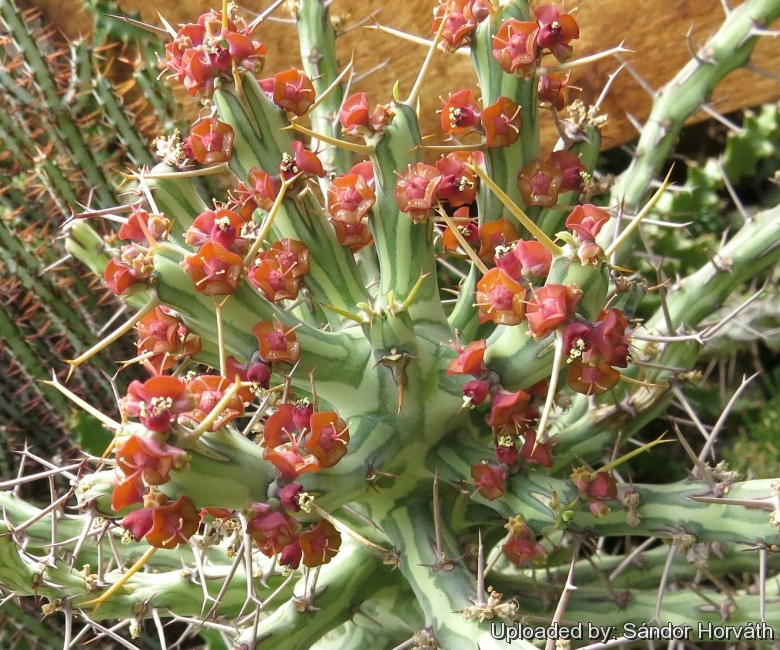
Euphorbia schizacantha Photo by: Sándor Horváth
Origin and Habitat: East Africa (Somalia, Ethiopia and in the northeast corner of Kenya)
Altitude: 200-500 m.
Habitat: It grows among stones on limestone soils, in the drier areas in the North it remains smaller and shows a more compact growth.
Synonyms:
See all synonyms of Euphorbia schizacantha
back
Accepted name in llifle Database:Euphorbia schizacantha PaxAnnuario Reale Ist. Bot. Roma 6: 187 1897Synonymy: 2
back
Description: Euphorbia schizacanthaSN|22921]]SN|22921]] is a densely branched, leafless and spiny cactus-like succulent growing to 60 (-120) cm tall, with branches up to 40cm long that are erect at first then drooping and trailing. In habit it is a pachycaul rather than a caudiciform species with a special beauty mottled stem. These side branches are usually themselves unbranched, cylindrical and up to 12mm thick. Euphorbia schizacanthaSN|22921]]SN|22921]] is sought after by plant collectors because of its drooping branches and because the fusion of the 2 main spines is not complete, thus having a forked tip.
Roots: Fibrous.
Main stem Thickened, fleshy, 5-6 cm in diameter and 30-50 cm tall, densely covered throughout with-spreading branches starting from the the base.
Lateral branches: up to 5-10(-40) cm long, rebranched only when mature, somewhat 4-angled, ascending, arching and trailing often drooping downwards to soil level, terete approx 6–12 mm in diameter longitudinally with 3-5 spiral series of shallow tubercles 1–2 cm apart striated with pale green and dark-green or tan bands.
Spine shield: Elongate, linear-decurrent horny, up to 1.5 cm long, 1,5-3 mm wide and quite separate.
Main spine: Solitary, up to 2,5 cm long apically branched derived from the incomplete fusion of the two upper spines. The tip of this fused main spine is split into a little fork with the two tips forming a narrow angle with one fork shorter and weaker than the other.
Stipular spines: 2 opposite, prominent, pointing laterally, 2-10 mm long.
Flower: On solitary cymes, the cyathia are simple, subsessile 5–6 mm in diameter variable in colour, from yellow to dark blood-red. (in particular the red flowering form is very fine-looking and appreciated by collectors, because also the plant body is clothed with very showy red, green and light green patterns). Nectar gland about 2.5 mm broad, rectangular deep brownish-red and contiguous. Styles 2 mm long.
Fruit: Capsule subsessile, 3,5 x 5 mm wide, deeply 3-lobed, tan-green flushed in red.
Bibliography: Major references and further lectures
1) Gabriella Harriet Schmelzer, Ameenah Gurib-Fakim “Medicinal Plants”, Volume 1 PROTA, 2008
2) J. G. Baker “Flora of Tropical Africa”, Vol 6, 1913
3) Urs Eggli “Illustrated Handbook of Succulent Plants: Dicotyledons” Springer Science & Business Media, 2002
4) “Flora Somalia”, Vol 1, (1993) Author S. Carter (Euphorbia, Monadenium), M. G. Gilbert (Acalypha, Andrachne, Antidesma, Bridelia, Caperonia, Cephalocroton, Chrozophora, Clutia, Dalechampia, Flueggea, Givotia, Manihot, Meineckia, Micrococca, Oldfieldia, Phyllanthus, Ricinus, Suregada, Tragia), and M. Thulin (Croton, Drypetes, Erythrococca, Excoecaria, Jatropha, Spirostachys and Thecacoris) [updated by M. Thulin 2008]
5) African Plants Database (version 3.4.0). “Euphorbia schizacantha Pax ” Conservatoire et Jardin botaniques de la Ville de Genève and South African National Biodiversity Institute, Pretoria, "Retrieved 02 October 2015", from <http://www.ville-ge.ch/musinfo/bd/cjb/africa/>.
 Euphorbia schizacantha Photo by: Valentino Vallicelli
Euphorbia schizacantha Photo by: Valentino Vallicelli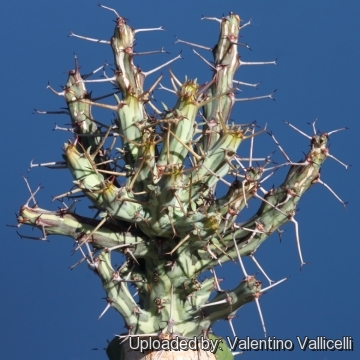 Euphorbia schizacantha Photo by: Valentino Vallicelli
Euphorbia schizacantha Photo by: Valentino Vallicelli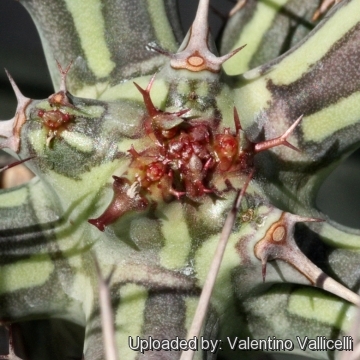 Euphorbia schizacantha Photo by: Valentino Vallicelli
Euphorbia schizacantha Photo by: Valentino Vallicelli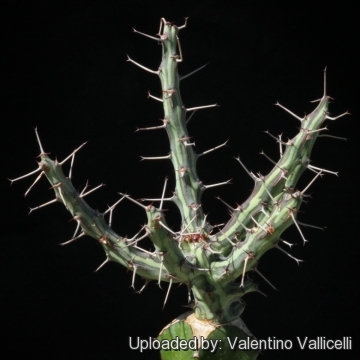 Euphorbia schizacantha Photo by: Valentino Vallicelli
Euphorbia schizacantha Photo by: Valentino Vallicelli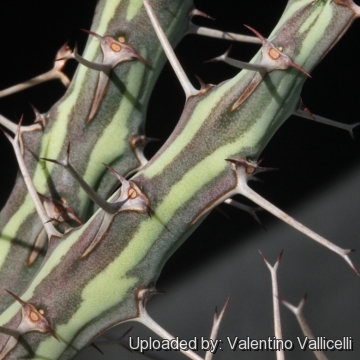 Euphorbia schizacantha Photo by: Valentino Vallicelli
Euphorbia schizacantha Photo by: Valentino Vallicelli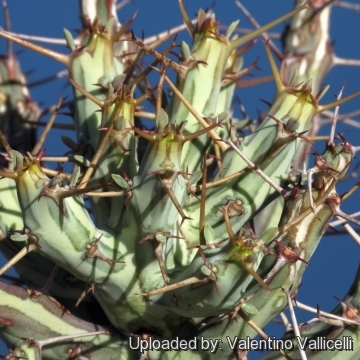 Euphorbia schizacantha Photo by: Valentino Vallicelli
Euphorbia schizacantha Photo by: Valentino Vallicelli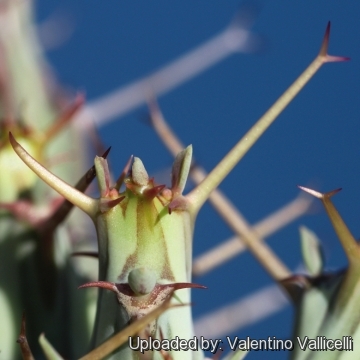 Euphorbia schizacantha Photo by: Valentino Vallicelli
Euphorbia schizacantha Photo by: Valentino VallicelliSend a photo of this plant.The gallery now contains thousands of pictures, however it is possible to do even more. We are, of course, seeking photos of species not yet shown in the gallery but not only that, we are also looking for better pictures than those already present.
Read More... Cultivation and Propagation: This specie has the fame to be quite tricky to cultivate. A very very light and warm place is highly appreciated, but full sun all day long stops the growth, which is not resumed very easily and will lead to the loss of the plant.
It does best in a mineral soil, good drainage is essential. Water sparingly during the summer months and keep dry in winter. In the short growing season it likes ample water and in this period it grows rather quickly, though not for a long time. When not in growth, Euphorbia schizacanthaSN|22921]]SN|22921]] is killed right away, when given too much water. It is a slow growing long lived plant and once established, it will be content in its position and with its soil for years. It can tolerate moderate shade, and a plant that has been growing in shade should be slowly hardened off before placing it in full sun as the plant will be severely scorched if moved too suddenly from shade into sun.
Propagation: It is propagated from seed sown during spring or summer. Germination occurs within 3 weeks. Sowing seed of this self fertile species is the surest method of growing typical offspring and seedlings are in the first season relatively easy to grow. It can be reproduced by cuttings or grafting as well but often lateral branches fail to produce the characteristic thick main stem.

















